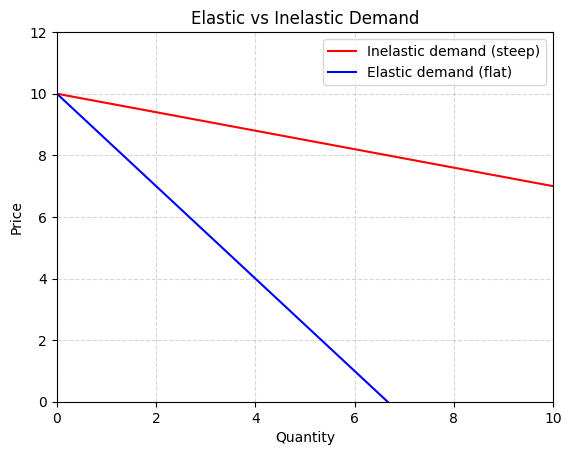Measuring responsiveness
Price elasticity of demand (PED) measures the responsiveness of the quantity demanded of a good to a change in its price. It is calculated as the percentage change in quantity demanded divided by the percentage change in price. According to Alt Academy, PED “measures the relationship between a change in the quantity demanded of a good and a change in the price of the good”【14935401651838†L23-L25】. A high PED means consumers are very responsive to price changes, while a low PED means they are less responsive.
Formula and interpretation
The formula for price elasticity of demand is:
PED = (% change in quantity demanded) ÷ (% change in price)
Values of PED are usually negative due to the inverse relationship between price and quantity demanded. However, economists often discuss the absolute value. The elasticity can be:
- Elastic (PED > 1) – a percentage change in price causes a larger percentage change in quantity demanded. Demand is sensitive to price.
- Inelastic (PED < 1) – a percentage change in price causes a smaller percentage change in quantity demanded. Demand is relatively insensitive to price.
- Unitary (PED = 1) – quantity demanded changes in proportion to price.
- Perfectly inelastic (PED = 0) – quantity demanded does not change when price changes.
- Perfectly elastic (PED = ∞) – consumers will only buy at one price; any increase leads to zero demand.

Determinants of elasticity
Several factors influence how responsive demand is to price changes:
- Availability of substitutes – the more substitutes a good has, the more elastic demand is.
- Proportion of income – goods that take up a large share of income tend to have elastic demand.
- Luxury versus necessity – luxury goods have more elastic demand; necessities are more inelastic.
- Time period – demand is more elastic in the long run when consumers can adjust habits.
- Habit‑forming products – goods like cigarettes tend to have inelastic demand.
| Elasticity value | Description | Example |
|---|---|---|
| PED > 1 (elastic) | Demand changes by a greater percentage than price | Restaurant meals, luxury holidays |
| PED < 1 (inelastic) | Demand changes by a smaller percentage than price | Basic food items, petrol |
| PED = 1 (unitary) | Demand changes in proportion to price | Many goods in the mid‑range of responsiveness |
| PED = 0 (perfectly inelastic) | No response to price changes | Life‑saving medicines |
| PED = ∞ (perfectly elastic) | Any increase in price eliminates demand | Identical products in a perfectly competitive market |
Understanding elasticity helps firms set prices and governments predict the impact of taxation. For example, a government tax on a good with inelastic demand (like cigarettes) generates revenue without greatly reducing consumption. In markets with elastic demand, firms may use price cuts to increase total revenue.
Calculation example
Suppose the price of a cup of coffee falls from $4 to $3.60 (a 10% decrease). As a result, daily sales rise from 100 to 120 cups (a 20% increase). Price elasticity of demand is calculated as:
PED = (% change in quantity demanded) ÷ (% change in price) = 20% ÷ (‑10%) = ‑2
The absolute value is 2, which means demand is elastic: the percentage change in quantity demanded is greater than the percentage change in price. In this case, lowering the price increases total revenue (because the rise in sales more than compensates for the lower price), so a cafe could use a discount to boost takings.